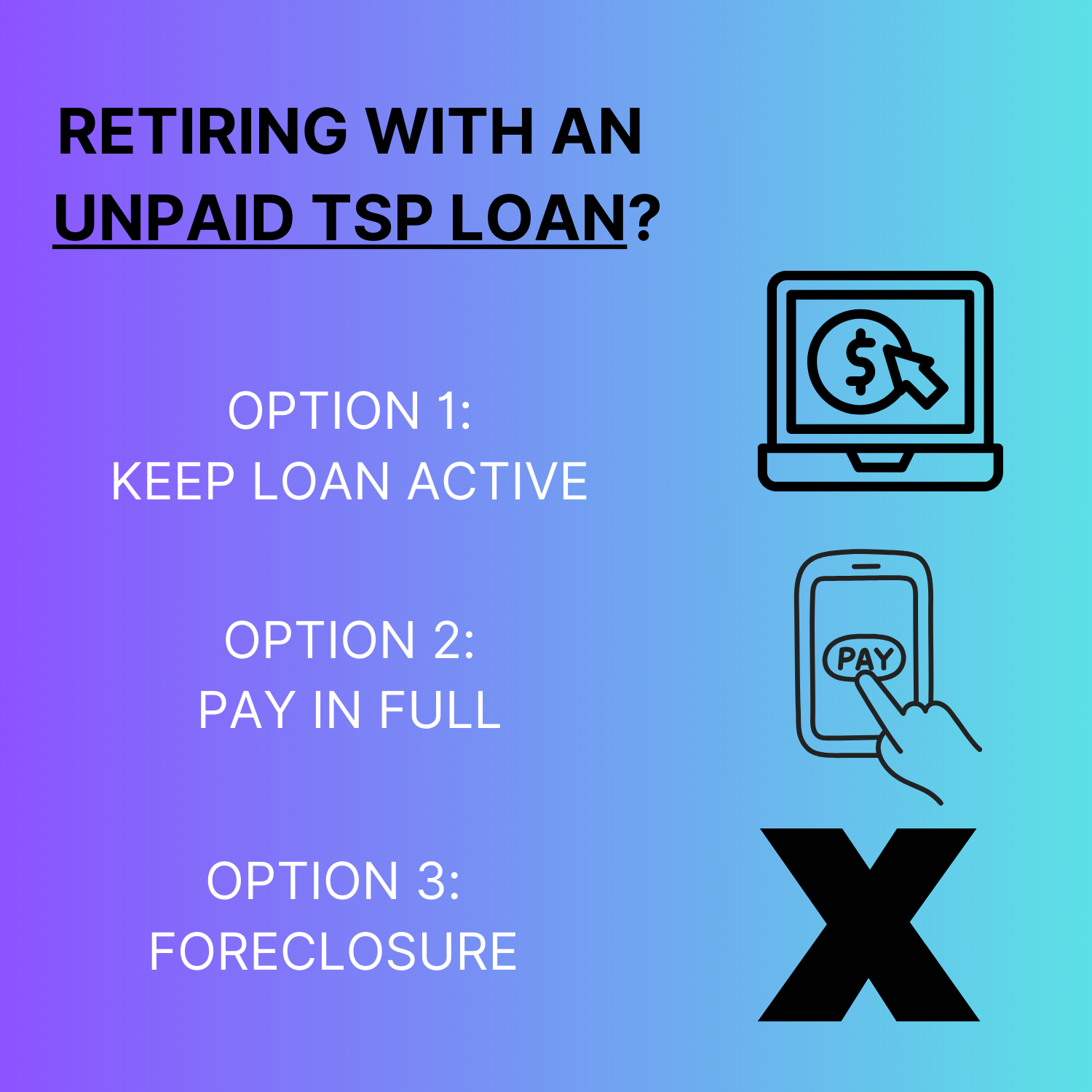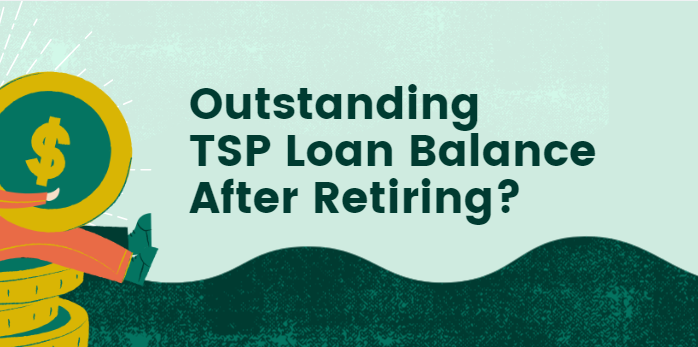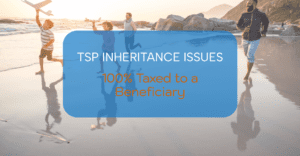Options for handling an unpaid TSP loan after retirement. Learn about the rules, payment deadlines, tax information, and more Thrift Savings Plan info.
Managing Your Thrift Savings Plan Loan at Retirement
Don’t let an unpaid TSP loan prevent you from retiring from the federal government. This article is designed to help TSP participants make the most informed decision while exploring all available options. Federal employees and military servicemembers can leave their public service position even if they still have an unpaid TSP loan.
Retiring from the Federal Government soon? Attend our free FERS Webinar.
Unpaid TSP Loan when Leaving Federal Service: 3 Options

Keep Paying the Loan Off with Monthly Payments
You can choose to keep the loan active. This is fairly new option for federal employees leaving the federal government with a unpaid loan in their Thrift Savings Plan account. Whether it’s a general purpose loan or a loan taken for a home purchase, the loan can be maintained under the original maximum timeframe. Instead of biweekly repayment amounts coming from payroll, however, the loan terms can be shifted to monthly payments that can be paid through automatic debits from a bank account, a check, or a money order mailed to the TSP. This can all be set up via the online account portal used to access your TSP account.
Direct debit is a convenient repayment method where loan payments are automatically deducted from your bank account. This option ensures that you do not miss any payments. To set up direct debit, you will need to provide your bank details to the TSP, and the agreed amount will be debited regularly until the loan is paid in full.
Need help planning your retirement from the federal government? Schedule a meeting and receive a 22-Page Benefit Analysis Report.
Pay Off the Outstanding Balance
If you have the funds to repay the loan balance within 90 days of leaving the federal government, then that is probably your best option. If the loan is not elected to be kept active (option 1), then there is a 90 day window in which the unpaid amount must be paid in full. Otherwise, you will have to worry more about IRS penalties and the tax implications of foreclosure (option 3). For more on the risks of leaving a job with an unpaid loan, see What Happens When You Retire or Quit with a TSP or 401(k) Loan Balance?
TSP Loans in Retirement: Foreclosure Consequences
If there is still a TSP loan after retirement and it is not handled within 90 days after leaving federal service (see options 1 and 2 above), then unpaid remaining balance is treated as a taxable distribution. Any accrued interest will then be considered as taxable income, subject to federal income tax. The Thrift Savings Plan’s rules require that any outstanding TSP loans be kept active through a payment plan or paid back within 90 days, or it will be declared a taxable distribution, impacting your tax liability significantly.
Additionally, if you have yet to reach the age where you’re allowed to make qualified withdrawals, you will incur an early withdrawal penalty of 10%. If retiring with an immediate FERS pension, this penalty can be avoided. Therefore, understanding these IRS regulations is crucial to avoid unnecessary financial burdens during retirement.
Can You Take Out a New TSP Loan After Retirement?
Unfortunately, you cannot take out a new TSP loan after retirement.
Stay up to date with Federal Benefits news – Subscribe to Our Newsletter
What Happens if You Do Not Repay the Loan?
If you do not repay the loan, the outstanding balance will be treated as a taxable distribution. This means that the unpaid amount will be added to your taxable income for the year, potentially pushing you into a higher tax bracket. Additionally, if you are under 55 (or 59.5), you may face an early withdrawal penalty. Therefore, it is crucial to have a repayment plan in place to avoid these financial consequences. Having any money in a Roth TSP account can make things more complicated.
Knowledge is Confidence!
Can You Rollover an Unpaid TSP Loan into an IRA?
What Are the Steps to Rollover the Loan?
Rolling over an unpaid TSP loan into an IRA is a potential option to avoid immediate tax implications. To do this, you must first ensure that the loan is declared as a distribution. Then, you have 60 days to rollover the withdraw into an IRA to defer taxes. This process involves completing specific paperwork and coordinating with both the TSP’s staff and your IRA provider to ensure a smooth transition.
Are There Any Time Limits for Rolling Over?
Yes, there is a strict 60-day time limit for rolling over the distribution into an IRA. If you miss this window, the distribution will be considered taxable, and you may face additional penalties. Therefore, it is crucial to act quickly and ensure all necessary steps are completed within this timeframe to avoid financial repercussions.
Should You Consult a Financial Advisor About Your TSP Loan?
Make the Best Decision for YOUR Situation
Consulting a financial advisor can provide numerous benefits when managing an unpaid TSP loan. A financial advisor can offer personalized advice based on your financial situation, helping you understand the implications of different repayment options and tax consequences. They can also assist in creating a comprehensive retirement plan that considers your TSP loan and other financial obligations.
Talk with a PlanWell Financial Planner for help. Schedule a meeting today.
How Can We Help with Retirement Planning?
Not just any financial advisor can help federal employees with retirement planning. Learn the PlanWell difference. We can help navigate complex financial decisions, provide insights into how your TSP loan affects your overall retirement strategy, and suggest ways to optimize your savings and investments. Additionally, we can help you understand the tax implications of your decisions and ensure you are taking advantage of all available federal employee benefits.
Reach Out to Us!
If you have additional federal benefit questions, contact our team of CERTIFIED FINANCIAL PLANNER™ (CFP®), Chartered Federal Employee Benefits Consultants (ChFEBC℠), and Accredited Investment Fiduciary (AIF®) professionals. At PlanWell, we are federal employee financial advisors with a focus on retirement planning. Learn more about our process designed for the career fed.
Preparing for federal retirement? Check out our scheduled federal retirement workshops. Sign up for our no-cost federal retirement webinars through this link. Make sure to plan ahead and reserve your seat for our FERS webinar, held every three weeks. Want to have PlanWell host a federal retirement seminar for your agency? Reach out, and we’ll collaborate with HR to arrange an on-site FERS seminar.
Want to fast-track your federal retirement plan? Skip the FERS webinar and start a one-on-one conversation with a ChFEBC today. You can schedule a one-on-one meeting here.











